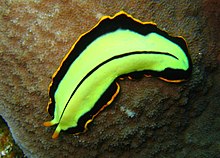| Pseudoceros dimidiatus | |
|---|---|

| |

| |
| Pseudoceros dimidiatus with a zebra pattern | |
|
Scientific classification
| |
| Domain: | Eukaryota |
| Kingdom: | Animalia |
| Phylum: | Platyhelminthes |
| Order: | Polycladida |
| Family: | Pseudocerotidae |
| Genus: | Pseudoceros |
| Species: | P. dimidiatus
|
| Binomial name | |
| Pseudoceros dimidiatus | |
Pseudoceros dimidiatus, the divided flatworm or tiger flatworm, is a species of flatworm in the genus Pseudoceros, belonging to the family Pseudocerotidae.
Description
Pseudoceros dimidiatus grows to be up to 8 centimetres (3.1 in). The body is elongated and oval, with a velvety dorsal surface, a grey-black ventral side and quite short pseudo tentacles formed by folds of the anterior margin.
All divided flatworms have a black body with an orange margin. Common characters are also two wide longitudinal yellow-greenish stripes usually separated by a narrow black median line. However, this species of Pseudoceros is highly variable in colour and in pattern, in terms of the arrangement and width of the various transverse stripes and of the width of the longitudinal stripes. It can take at least three different types of liveries, all with the same colours, which threaten its being inedible. It has bilateral symmetry.
The bright and contrasting colors serve as a warning for predators to not eat this inedible species. These flatworms feed exclusively on colonial ascidians. They are also cold blooded. [1]
Distribution
This species is widespread in the Indian Ocean from the Red Sea to Australia and in the Western Pacific Ocean. [1]
Reproduction
The divided flatworm can reproduce both asexually, by dividing itself, and sexually. The species is a hermaphrodite, meaning that they have both male and female reproductive organs. When two flatworms reproduce they battle to decide who gets to fertilize and who is fertilized. The winner gets to act as the male, fertilizing the other. [1]
Habitat
The divided flatworm lives in coral reefs in the tropical waters.
Bibliography
- Leslie Newman et Lester Cannon, Marine Flatworms, 2003 ( ISBN 0-643-06829-5)
- Neville Coleman, La vie marine des Maldives, 2004 ( ISBN 1-876410-54-X)
- http://diveadvisor.com/sub2o/fantastic-flatworms
Original text
- Kent : The Great Barrier Reef of Australia; its products and potentialities. W.H. Allen, London ( Full text).
References
- ^ a b c "Flatworm articles - Encyclopedia of Life". eol.org. Retrieved 2024-01-01.
External links
- Photos of Pseudoceros dimidiatus on Sealife Collection